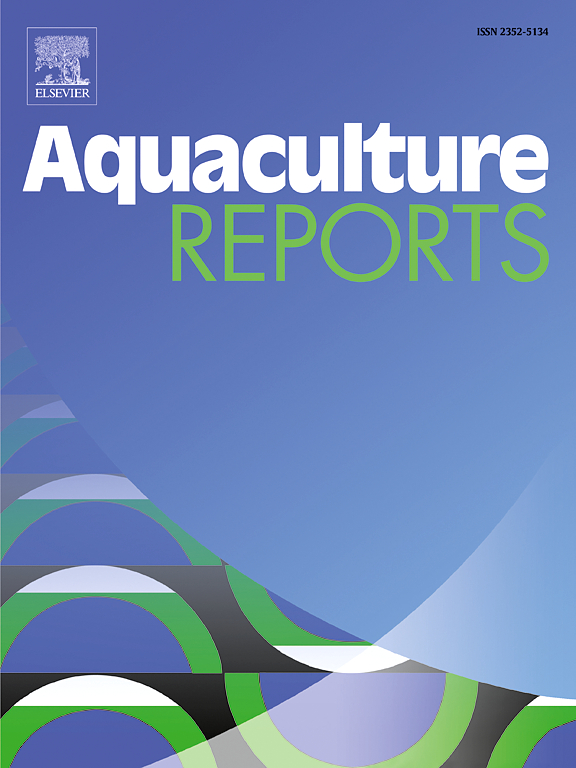Surfactin, bacillibactin and bacilysin are the main antibacterial substances of Bacillus subtilis JSHY-K3 that inhibited the growth of VpAHPND (the main pathogen of acute hepatopancreatic necrosis disease in shrimp)
IF 3.2
2区 农林科学
Q1 FISHERIES
引用次数: 0
Abstract
Acute hepatopancreatic necrosis disease (AHPND), which is caused by a particular strain of Vibrio that carries the pirA and pirB virulence protein gene, has caused major economic losses in shrimp farming. Bacillus subtilis JSHY-K3, a bacterial strain apparently antagonistic to VpAHPND, was screened by our laboratory to better control AHPND. Our previous whole-genome sequencing analysis and untargeted metabolomics-LCMS-EMDB analysis of strain JSHY-K3 revealed that its antimicrobial material could be surfactin, aurantinin B/C/D, fengycin, sublancin 168, bacillibactin, subtilosin A, bacilysin, caffeic acid, fosfomycin, minocycline and so on. However, the specific bacteriostatic substances remain unclear and need to be further investigated. In this study, based on the whole genome sequence information obtained previously, we used CRISPR/Cas9 technology to edit the genome of B. subtilis JSHY-K3 and constructed 6 strains of gene knockout mutants, among which the bacterial solution and cell-free culture medium of the mutants ΔsrfAB-AC, ΔdhbC and ΔbacA showed a significant decrease in antagonism to VpAHPND. Therefore, we suspected that the main antibacterial substances of B. subtilis JSHY-K3 may be surfactin, bacillibactin and bacilysin. We then carried out high-resolution mass spectrometry and three-quadrupole quantitative analysis on the fermentation supernatants of strains JSHY-K3, ΔsrfAB-AC, ΔdhbC and ΔbacA, and confirmed that these three gene clusters are involved in the synthesis of surfactin, bacillibactin and bacilysin, respectively. It was also confirmed that the deletion of the srfAB-AC, dhbC, bacA genes led to a reduction in the synthesis of surfactin, bacillibactin, bacilysin, which in turn led to a decrease in the inhibitory ability of the three mutant strains against VpAHPND. In conclusion, surfactin, bacillibactin and bacilysin are the main inhibitory substances of B. subtilis JSHY-K3 to inhibit the growth of VpAHPND.
枯草芽孢杆菌jhy - k3抑制虾急性肝胰腺坏死病主要病原体VpAHPND生长的主要抑菌物质为表面素、芽孢杆菌素和杆菌素。
急性肝胰腺坏死病(AHPND)是由一种携带pirA和pirB毒力蛋白基因的特殊弧菌引起的,给虾养殖造成了重大的经济损失。为了更好地防治AHPND,本实验室筛选了一株对VpAHPND具有明显拮抗作用的枯草芽孢杆菌jhy - k3。我们前期对菌株jhy - k3进行了全基因组测序和非靶向代谢组学- lcms - emdb分析,结果表明菌株jhy - k3的抗菌物质可能为surfactin、aurantinin B/C/D、fengycin、subblancin 168、bacillibacactin、subtilosin A、bacilysin、咖啡酸、磷霉素、米诺环素等。然而,具体的抑菌物质尚不清楚,需要进一步研究。本研究在前期获得的枯草芽孢杆菌jsh - k3全基因组序列信息的基础上,利用CRISPR/Cas9技术编辑枯草芽孢杆菌jsh - k3基因组,构建了6株基因敲除突变体,其中突变体ΔsrfAB-AC、ΔdhbC和ΔbacA的菌液和无细胞培养基对VpAHPND的拮抗作用显著降低。因此,我们怀疑枯草芽孢杆菌jsh - k3的主要抑菌物质可能是表面素、杆菌素和杆菌素。然后我们对菌株jhy - k3、ΔsrfAB-AC、ΔdhbC和ΔbacA的发酵上清液进行了高分辨率质谱和三四极杆定量分析,证实这三个基因簇分别参与了surfactin、bacillibactin和bacilysin的合成。同时证实srfAB-AC、dhbC、bacA基因的缺失导致surfactin、bacillibactin、bacilysin的合成减少,从而导致三种突变菌株对VpAHPND的抑制能力下降。综上所述,枯草芽孢杆菌jsh - k3抑制VpAHPND生长的主要抑制物质为表面素、杆菌素和杆菌素。
本文章由计算机程序翻译,如有差异,请以英文原文为准。
求助全文
约1分钟内获得全文
求助全文
来源期刊

Aquaculture Reports
Agricultural and Biological Sciences-Animal Science and Zoology
CiteScore
5.90
自引率
8.10%
发文量
469
审稿时长
77 days
期刊介绍:
Aquaculture Reports will publish original research papers and reviews documenting outstanding science with a regional context and focus, answering the need for high quality information on novel species, systems and regions in emerging areas of aquaculture research and development, such as integrated multi-trophic aquaculture, urban aquaculture, ornamental, unfed aquaculture, offshore aquaculture and others. Papers having industry research as priority and encompassing product development research or current industry practice are encouraged.
 求助内容:
求助内容: 应助结果提醒方式:
应助结果提醒方式:


